Baseball pitching great Sandy Koufax was looking to supplement his Los Angeles Dodgers salary when he bought the Tropicana Motel on Santa Monica Boulevard in 1962. The motor lodge, with low weekly rates and kitchenettes in all 74 rooms, was built from the get go as short- and long-term housing for those who couldn’t afford apartments.
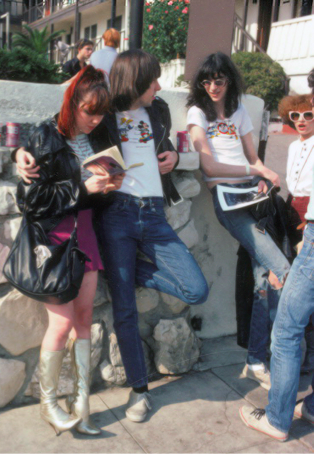
Clientele at the time consisted mostly of musicians, mystics and B-list television character actors. Koufax wanted to bring in new business and added his name to the marquee, banking on his fame to draw better heeled guests. The rich and famous, though, didn’t patronize “Sandy Koufax’s Tropicana Motel” as he had hoped.
It was timing and location-location-location instead that combined to deliver new business in the form of sex-and-drugs-and-rock-n-roll. The motel’s most enthusiastic clients were the working rock bands that found it inexpensive and close to the Troubadour in particular as well as other West Hollywood clubs just as the 1960s rock revolution was taking off. These new guests especially noticed that the Tropicana was “possessed of a benign seaminess that was close to their hearts,” in the words of the Los Angeles Times.
What Koufax got for his investment was one big hang-out, party place and crash pad for rockers who made “The Trop” a natural first stop on their way up the rock and roll ladder, as well as a place to stay after they had made it. Eclectic guests continued to frequent the place, turning it into a Chelsea Hotel of the West with AstroTurf around the kidney-bean shaped swimming pool.
“From 1963 onward, the Trop functioned as a bohemian playground, pioneered by Jim Morrison and the Doors, who hung around The Palms, a low-rent (and nearly as infamous) lesbian bar located directly across the street from the Tropicana,” states an article on Slake LA titled “Tales from the Tropicana Motel. “He would drink there all night before stumbling across the street to pass out. Mornings after, he’d write many of the songs that became hits for the Doors. Waves of other musicians arrived and followed the same hit-making formula.”
Former residents and guests comprise the who’s who of rock music. Morrison lived at the Tropicana for three years during his glory days with The Doors. The group recorded its last album with Morrison, “L.A. Woman,” at its studio right across Santa Monica Boulevard from the motel.
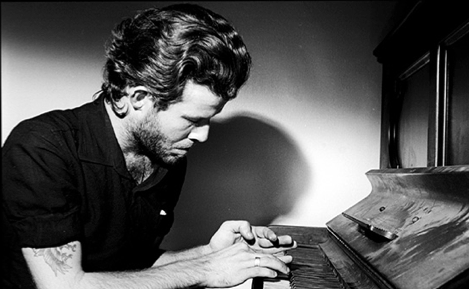
Gravel-voiced singer Tom Waits, once described as “minstrel-in-chief” of America’s urban underbelly, resided in one of the motel’s bungalows for nine years. Working from a Steinway upright piano in a far corner of his bungalow’s kitchen, Waits delivered his fourth album in 1976, “Small Change,” which the Los Angeles Times deemed “The tour de force that established his reputation as an outright original.
Van Morrison wrote “T.B. Sheets” and several other songs while staying at the Tropicana. Big Brother and the Holding Company, Rhinoceros, Bob Marley and the Wailers and Alice Cooper all made the Tropicana their Hollywood base of operation at one time or another. A pre-Fleetwood Mac Stevie Nicks and Lindsey Buckingham holed up at the Tropicana when they came to Hollywood and got their first recording contract; their debut album, “Buckingham-Nicks,” was released in 1973.
Joan Jett lived at the Tropicana as a little girl and was a regular guest as an adult. Punk and new wave acts like The Dickies, The Dead Boys, The Ramones and Blondie all stayed there when they were in town. Tom Petty’s Heartbreakers lived there too.
When Elektra Records built a state-of-the-art recording studio close to the motel in 1967 at 962 N. La Cienega Blvd., its artists were housed at the Tropicana. Janis Joplin, Bruce Springsteen, Frank Zappa, Alice Cooper, Led Zepplin, the Mamas and the Papas, the Beach Boys, Jim McGuinn of the Byrds and Martha and the Vandellas, the list goes on. Other regulars included Sly and the Family Stone and Chuck E. Weiss, along with Ricki Lee Jones.
One guest is said to have remarked, “I don’t know which made me more excited – to be in Sandy’s motel or to be in a room right beside Sly Stone, from Sly and the Family Stone.” “The clientele also included tourists who innocently happened to share their Hollywood vacations with hookers, pimps and junkies,” the Slake LA article notes.
Rockers were joined by all stripes of show business types at the motel. Two Andy Warhol underground movies were filmed at the Tropicana: “Heat” (1972), a parody of Sunset Boulevard starring Joe Dallesandro and written by Paul Morrissey, and “Trash” (1970), also written by Morrissey and starring Dallesandro, according to the Internet Movie Database.
The Los Angeles Times gave additional insight into the goings-on at the motel in a 2014 article that reported, “William S. Burroughs, the cult figure and beat author who wrote ‘Naked Lunch’, occasionally was spotted at pool-side. Singer-songwriter Ricki Lee Jones is said to have spent more than one night curled up in a Tropicana lawn chair.”
“24-Hour Orgy Owned by the Former Dodger Great”
The Tropicana’s pool was kidney bean-shaped and painted black “probably so they don’t have to clean it so often,” Waits once surmised. Others concluded the black paint was needed to hide rust stains from patio furniture that was regularly tossed in the pool during parties.
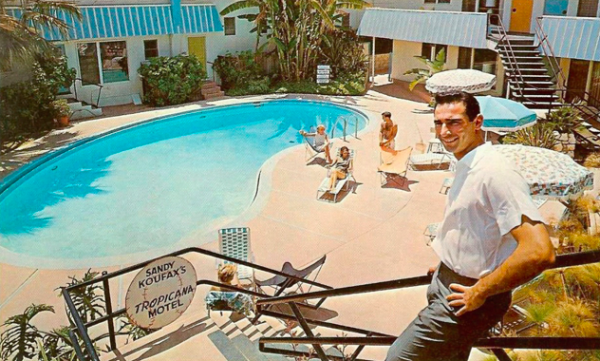
“Regulars knew better than to dive into the pool – you might have an underwater rendezvous with a chaise lounge, or worse, a syringe or two,” according to the Slake LA article.
Given the crowd, there wasn’t any wonder about accuracy when mainstream magazines described the Tropicana as “a bohemian playground where some parties lasted for months.” The L.A. Weekly in particular called it “the 24-hour orgy owned by the former Dodger great.”
Under the Trop’s jungle-like foliage there were orgies, murders, suicides, over-doses, love triangles, marriages and drunken brawls on a daily basis,” Slake LA reports. “There were even a number of struggling bands living in their cars in the Trop’s back parking lot (which the management was fully aware of).”
The Los Angeles Review of Books, in a 2012 article about the book “Low Side of the Road: A Life of Tom Waits” by Barney Hoskins, assessed the motel this way: “There is a kidney shaped swimming pool in the courtyard,” William Burroughs wrote in Rolling Stone in 1980. “On the patio are rusty metal tables, deck chairs, palms and banana trees: a rundown Raymond Chandler set from the 1950s. One expects to find a dead man floating in the pool one morning.”
The book review continues, “This pleasingly named, deeply unsanitary West Hollywood motel was featured as the main location for Paul Morrissey’s film Andy Warhol’s “Heat” (1972) and was already renowned for its cool sleaze by the time Waits checked into his two-room apartment in 1976.”
Waits recalled in a 1992 interview, “I had a place at the back and I was very happy back there – fresh towels, clean-up maid, it was very nice. I don’t think I got any new towels for the whole like nine years I was there. But I never asked. I didn’t want to upset anybody.”
Compared with Sunset Boulevard’s glamour and bright lights, Santa Monica Boulevard back then was gritty and dark. Trains still ran down the middle of the street, which was lined with various auto parts, repair and wreckage shops, lumber yards, liquor stores and warehouses.
It doesn’t take a stretch of the imagination to figure out why Koufax, the motel’s fourth owner since it was built in 1947, sold it in the late 1960s to a partnership headed by Jerry Heiner. In the L.A. Times article, Heiner says, “It was a funky place, no doubt about that.” Heiner owned the property during much of the 1970s and early 1980s, a period when the motel and Duke’s Coffee Shop, its resident eatery, became meccas for rock musicians and the occasional movie star.
Poor artists and musicians flocked to Duke’s for its copious servings of good, inexpensive food. Music and film executives ate there as well, noted Slake LA, which said “Cassettes and scripts were passed across the greasy Formica countertops; romances were kindled over hangovers.”
The Long Party Comes to an End
“When the Tropicana’s escapades came to a grinding halt in 1988 after three decades, it marked the end of an era or two or three,” Slake LA reports. “It had stood as bacchanalia central in the time before AIDS and MTV, before demographics and gentrification, and before the Reagan revolution. While it lasted though, the Trop was ground zero for some of the best times that the underbelly of L.A. ever saw.”
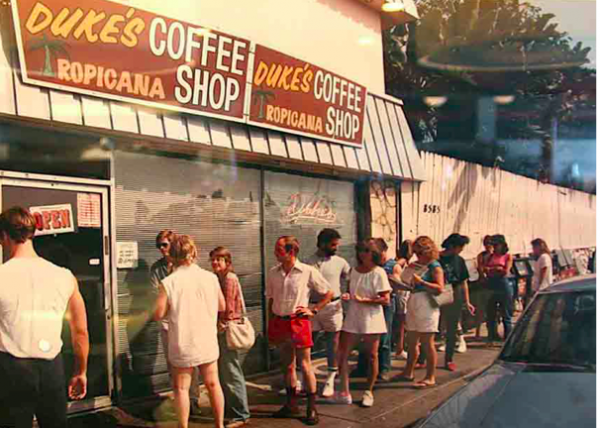
The motel was located near the end of Route 66, the great Mother Road for migrants headed to Los Angeles from Chicago. The last guests of sorts to check in were those on a wrecking crew that reported for work in October 1987 to demolish what had become a shrine to youth and hedonism. Today the 178-unit Ramada Plaza West Hollywood Hotel and Suites stands in the spot where “a piece of pop history … once slouched,” as the Los Angeles Times notes.
Developer Yehuda Naftali purchased the property in 1984, saying he was sympathetic to the Tropicana’s history and ambiance. But the motel was falling apart from all the partying, he said, and “impossible to keep in its present (1987) condition.” By then most rooms had been completely trashed by all-night partying, and iffy plumbing often meant flooded rooms.
Then there were the effects of the proposed Beverly Hills Freeway, which essentially caused property owners along Santa Monica Boulevard to delay for many years, or stop altogether, upkeep and maintenance. According to KCET.org, the freeway would have been a 9.3-mile, cross-town superhighway connecting the Westside’s 405 with Hollywood’s 101. As first proposed in the early 1940s, the freeway would have relieved pressure on the 10 and provided local freeway access to West Hollywood, Beverly Hills and Century City.
It also would have roughly followed the path of Santa Monica Boulevard, tearing through some of L.A.’s wealthiest residential districts – a fact that ultimately relegated plans for the freeway to the trash bin when state officials got serious about building it in the mid-1960s.
The freeway would have cut a wide swath and taken the Tropicana Motel with it. Planners threatened eminent domain and bought property along the proposed route, casting a pall over Santa Monica Boulevard for decades. Consequently, little repair and maintenance was done to the Tropicana and surrounding properties in anticipation of the freeway coming through.
The Tropicana’s Implications for Major League Baseball
As improbable as it may seem at first blush, Presidential historian Michael Bechloss, writing in The New York Times in 2014, put forth a theory, “How Sandy Koufax’s motel helped lead to baseball’s big-money era.” The highly regarded historian states, “A major league star of that time (early to mid-1960s) was well paid but not so lavishly as the highest paid players today.”
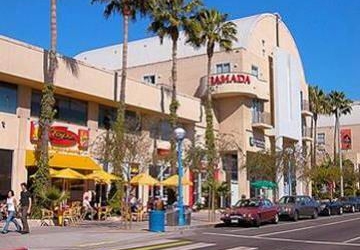
Koufax’s fellow pitcher, in fact, owned a cocktail bar in Van Nuys called “Don Drysdale’s Dugout Lounge.” In 1965, Koufax was earning $85,000. Drysdale took in $80,000. Prior to the 1966 season, they staged a double holdout during spring training that lasted for 32 days. Both players were represented by an entertainment lawyer, J. William Hayes, which was unusual during an era when players didn’t have agents.
Trying to overturn the usual year-to-year method of major league baseball bargaining, the two men jointly demanded that the Dodgers pay them $1 million over three years, divided equally between them. Drysdale ultimately agreed to a salary of $110,000 for the season, and Koufax snagged $125,000. Koufax’s new salary was nearly the same as that of Willie Mays, the best-paid man in baseball.
Concerned about possible holdouts by other players, Dodgers General Manager Buzzie Bavasi insisted the following year that the Koufax-Drysdale tactics “only worked because the greatest pitcher in baseball was in on it,” and vowed, “It will never happen again.” Bechloss notes, “But Bavasi was wrong. The holdout changed the relationship between baseball management and players, paving the way for the big money game of our day.
Just after the standoff ended, Arthur Daley of The New York Times called the settlement “baseball’s first collective bargaining arrangement,” writing, “There are aspects of unionism to it and no one in this sport of rugged individualists ever was confronted with such a thing before.” Koufax later agreed that his partnership with Drysdale was like a labor union – “a very small union, just the two of us, Don and myself.”
Drysdale was happy to pocket his raise, but for him, the holdout brought one unpleasant surprise. Arguing that what was good for the goose was good for the gander, the employees of his cocktail lounge told him they deserved more money, too.

Dukes was the place in the 80’s for brunch – we all sat at long tables and talked to whomever sat next to you.. Those were the days…
who was the architect of this motel? does anyone know?
As I remember “Dukes” was supposed to return to the location after the Ramada was built. About two years ago I attempted to take relative to “Dukes” on Sunset Strip for breakfast only to discover it was out of business although it had just been featured on a West Hollywood program highlighting good eateries by two older gentlemen.
Great article. I used to love going to DUKE’s and LOVED dropping into The Tropicana to join various parties, groups, celebrations that went into and through the nights. Trop was also the place many wannabes stayed when first arriving in LA…miss the place and the atmosphere of hope, promise, excitement and positive attitudes!